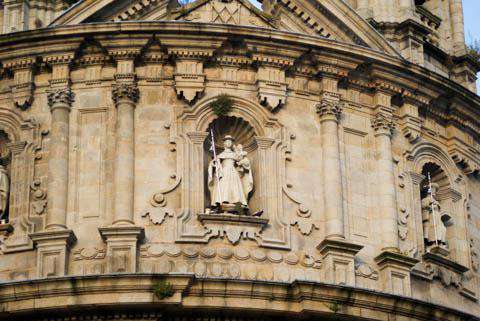Pontevedra On a Budget
 Pontevedra, Spain
Pontevedra, Spain
Sights
Plazas and architecture dominate the main sights of this Galician city. One of Pontevedra's most distinct attractions is probably the Chapel of the Pilgrims situated in one of the plazas of Fererria Square. The chapel is unique not only for its rounded façade but for its mix of Baroque detailing with some neo classical design elements. Another notable church is the striking Basilica de Santa Maria a Maior which has a long relationship with the city's seafaring history, while the Gothic Santo Domingo church exists in beautiful ruins. The list of churches and their history goes on.In regards to plazas, Ferraria Square is the hub of Pontevedra, made up of many smaller plazas including Praza de Peregrino, Praza da Estela, Praza de Curros Enriquez, Praza do Teucro, and Praza da Lena. Each is enveloped in an atmosphere unique to Pontevedra, with the bustling activities of contemporary visitors amongst squares and buildings from another time.
Other important sights include two bridges stretching across the Lerez River-the Ponte do Burgo and the Roman bridge of Pontesampaio
Neighborhoods
The Praza da Ferreria is a large and bustling square located at the heart of Pontevedra's old quarter. It is, in reality, a collection of smaller plazas embodying an atmosphere full of activity and visitors from all over. Surrounded by market stalls, shopping, cafes, and some of the quarter's historic sights, the Ferreria Square serves as a central hub, the happening place to be. Also existing in the old part of the city is the Pazo do Concello or town hall, many historic churches, old world architecture, and other famous plazas. Another main square is Pontevedra's Alameda, located at the southern edge of the city's sightseeing attractions. It is a main venue for festivals and has a busy tourist booth with English language booklets available.Activities
In addition to exploring the architectural sights and plazas, visitors often visit the Pontevedra Museum which is housed in a complex of baroque and gothic buildings. With a collection of Spanish & Galician art and artifacts from the Middle Ages to the 20th century, it is considered to be one of the finest historical and archeological museums in Spain. It also includes the ruins of Santo Domingo Church and the Edificio Sarmiento, an old convent.Another neat place to see is the Illa de Esculturas, or Island of Sculptures, which exists as an open air sculpture garden featuring the works of Francisco Leiro, Giovanni Anselmo, Fernando Casás, Dan Gram, and Ian Hamilton, amongst others. Each piece is integrated into the landscape of flora and fauna native to the area.
Other activities include Pontevedra's festivals which occur over the course of the year. Most are religious celebrations, while others have evolved over the years to have myths and legends associated with the festivities.
Food and Dining
Cuisine of Pontevedra is typical of that of the Galicia region as a whole-with seafood being particularly popular. The Spanish word for seafood is "marisco," and fresh catches include things like clams, mussels, pod razors, cockles, crabs, barnacles, crayfish, snails, lobster, squid, sea bass, hake, scorpion fish, anchovies, sardines, and tuna. Pulpo a feira is a common seafood dish of octopus prepared with oil, salt, and hot paprika. Then there are empanadas-pies made with a traditional dough, filled with onion, pepper, and some meat, usually tuna, veal, or seafood. Another specialty of Galicia is a type of stew called Caldo Galego, which is simple but satisfying for warding off the damp chill of the region's climate. It is a common winter dish as is Lacón con grelos, which consists of pork cooked with turnip, potatoes, and chorizo. Dining options are concentrated in the central part of the city, around and just north of the Praza de Ferreria.Transportation
By plane, the nearest airports to Pontevedra are Peinador Airport in Vigo and Santiago de Compostela Airport in Lavacolla. Both are only about 30-40 minutes away via the Atlantico highway (AP-9). Flights from these airports connect to Madrid, as well as other cities in Spain and Europe (including London, Paris, Geneva, and Frankfurt).By rail, RENFE trains run daily back and forth from Madrid and Barcelona. The train station is located on Rua da Estacion. The bus station is also located here, providing services to many destinations in Spain, Portugal, and beyond.
Related:
Looking for a party in Barcelona or Madrid?
Traveling alone to Granada or Seville?
Find a Contiki tour to Europe.

 Budget Your Trip is all about finding out how much everything costs so that you can travel cheaper and longer. Created by avid travelers Laurie and Bryan, our goal is to help you plan your next trip on the right budget. With average daily travel costs that are calculated from the budgets of real travelers, plus an analysis of hotel and tour prices, you can find out how much money you need to plan your next adventure. We also have plenty of travel advice, accommodation reviews, and activity suggestions.
Budget Your Trip is all about finding out how much everything costs so that you can travel cheaper and longer. Created by avid travelers Laurie and Bryan, our goal is to help you plan your next trip on the right budget. With average daily travel costs that are calculated from the budgets of real travelers, plus an analysis of hotel and tour prices, you can find out how much money you need to plan your next adventure. We also have plenty of travel advice, accommodation reviews, and activity suggestions.